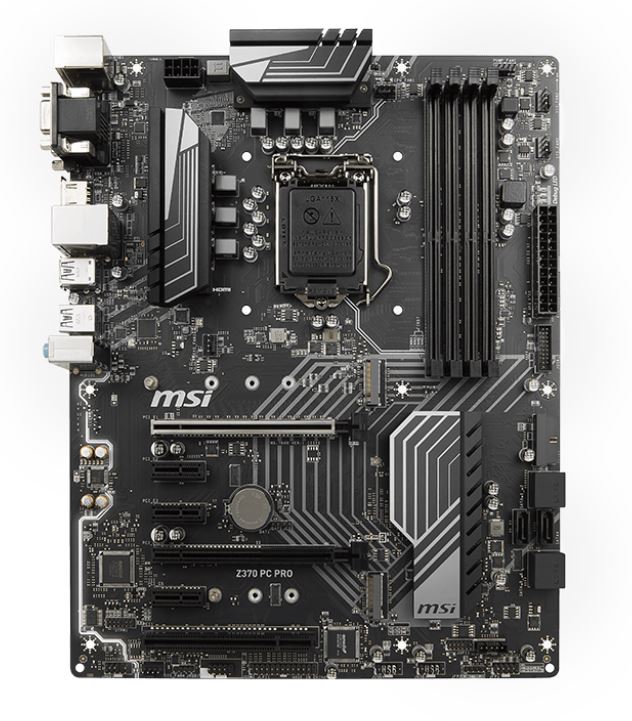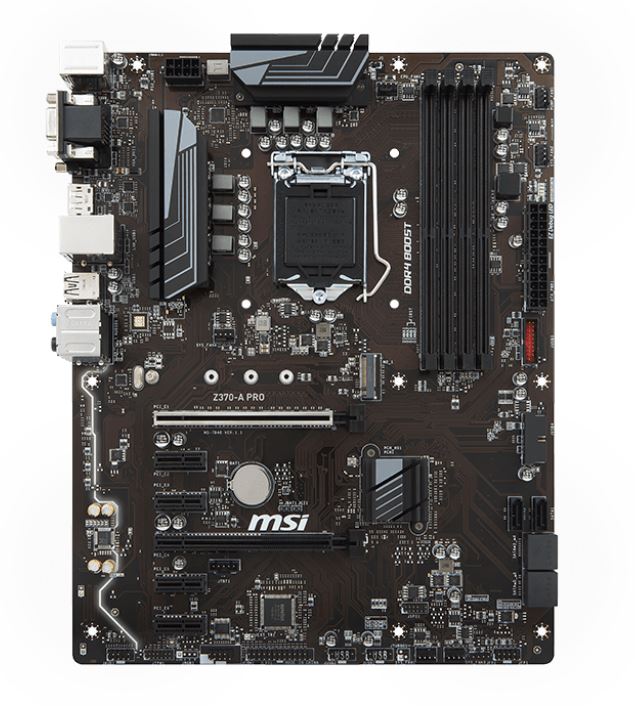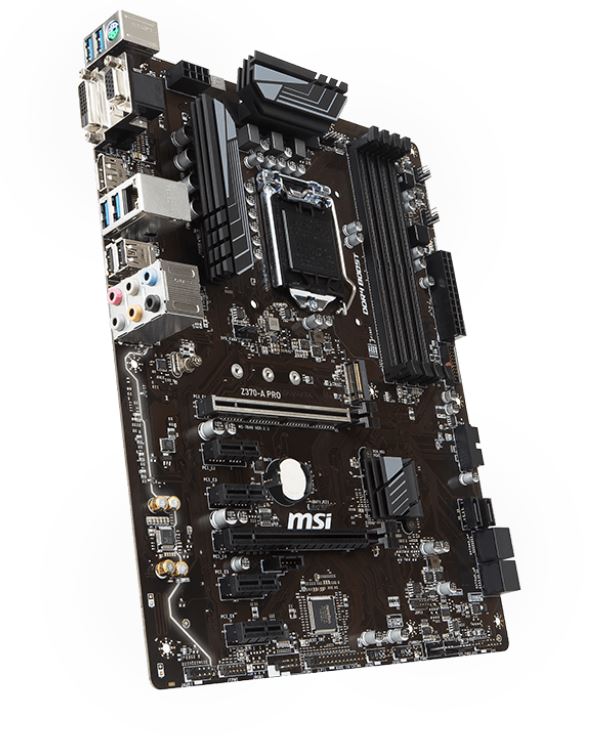Analyzing Z370 for Intel's 8th Generation Coffee Lake: A Quick Look at 50+ Motherboards
by Ian Cutress, Anton Shilov, Joe Shields & Gavin Bonshor on October 20, 2017 2:00 PM ESTMSI Z370 PC Pro and MSI Z370-A Pro
The Pro series consists of two motherboards, the Z370 PC Pro and Z370-A Pro. Both boards use the same six-phase power delivery found in the Gaming Plus. Outside of storage, USB, PCIe support, and the aesthetic differences, both Pro boards keep similar specifications.
The PC Pro goes with a jet black PCB with a silver pattern focused around the chipset heatsink. That same pattern makes its way on the black VRM heatsinks. All the slots and connectors are black with the only reinforced slot being the primary PCIe. Except for the audio separation line, all the RGB LEDs are found on the back of the board creating a glow behind the motherboard. The PC Pro does offer a single RGB header for connecting an RGB strip, enhancing the existing lights.
The Z370-A Pro, on the other hand, is more of a plain brown board with the only patterns on it being the hundreds of visible traces snaking from part to part. The VRM heatsinks, memory slots, and PCIe slots are all black. Like its bigger brother, the first slot is reinforced. The Z370-A Pro uses all white LEDs (no other colors) on the back as well as the audio line. To some users rejoicing, there are no RGB headers on this board.


Z370 PC Pro (left), Z370-A Pro (right)
Memory support on both of the boards is the same, with four memory slots up to 64GB and supported speeds up to DDR4-4000. Both boards have two full-length PCIe slots, the first one being reinforced and x16 from the processor with the second not being reinforced and x4 from the chipset. Where the Z370-A Pro has four PCIe x1 slots, the PC Pro replaces one of them and adds a legacy PCI slot at the bottom.
The Z370-A Pro and PC Pro make the full set of six SATA ports available to users, with four regular placed ports and two vertical, although the layout of where they are is slightly different. The Z370-A Pro has the vertical SATA ports above the other four, while the PC Pro slides the vertical ports between the other four, due to the support of other features.
Fan header count and location are the same on both boards with six 4-pin connectors around the board, four of which are around the chipset. All of these headers support both PWM and voltage control for greater flexibility. For audio and networking, the PC Pro has the ALC887 and Intel I219-V, while the Z370-A Pro has the ALC892 and Realtek TRL8111H. Both boards use Capicon audio caps, and the audio traces are separated from the other portions of the board in an effort to reduce interference.


Z370 PC Pro (left), Z370-A Pro (right)
The PC Pro offers users USB 3.1 (10 Gbps) capabilities through the ASM3142 chipset and offers one Type-C port and one Type-A port on the back panel, while the Z370-A Pro does not offer 10 Gbps support. Both boards offer four eight USB 3.1 (5 Gbps) Type-A ports and two USB 2.0 ports on the back panel. Both boards have a combination PS/2 connector, video outputs, Ethernet, and an audio stack, although the PC Pro uses a HDMI and 2.1 audio, while the Z370-A Pro uses DisplayPort and 7.1 audio. Both boards have D-Sub and DVI-D connectors.
| MSI Z370 PC Pro and A Pro | ||
| Warranty Period | 3 Years | |
| Product Page | Link | Link |
| Size | ATX | |
| CPU Interface | LGA1151 | |
| Chipset | Intel Z370 Express | |
| Memory Slots (DDR4) | Four DDR4 Supporting 64GB Dual Channel Support DDR4 4133+ |
|
| Network Connectivity | 1 x Intel I219-V | 1 x Realtek RTL8111H |
| Onboard Audio | Realtek ALC887 | Realtek ALC892 |
| PCIe (CPU) | 2 x PCIe 3.0 x16 slots @ x16 / x4 | |
| PCIe (PCH) | 1 x PCIe 3.0 x4 3 x PCIe 3.0 x1 |
1 x PCIe 3.0 x4 4 x PCIe 3.0 x1 |
| SATA | 6 x Supporting RAID 0/1/5/10 | |
| Onboard SATA Express | None | |
| Onboard M.2 | 2 x PCIe 3.0 x4 or SATA | 1 x PCIe 3.0 x4 or SATA |
| Onboard U.2 | None | |
| USB 3.1 (10 Gbps) | 1 x Type-C (ASMedia) 1 x Type-A (ASMedia) |
None |
| USB 3.1 (5 Gbps) | 4 x Rear Panel 2 x Headers |
|
| USB 2.0 | 2 x Rear Panel 2 x Headers |
|
| Power Connectors | 1 x 24-pin EATX 1 x 8-pin ATX 12V |
|
| Fan Headers | 1 x 4-pin CPU 1 x 4-pin Waterpump 4 x 4-pin System Fan (All PWM or Voltage controlled) |
|
| IO Panel | 1 x PS/2 keyboard/mouse 1 x VGA port 1 x DVI-D port 1 x HCMI Port 1 x LAN (RJ45) port 4 x USB 3.1 Gen 1 ports 1 x USB 3.1 Gen 2 Type-A 1 x USB 3.1 Gen 2 Type-C 2 x USB 2.0 Type A Audio Jacks |
1 x PS/2 keyboard/mouse 1 x VGA port 1 x DVI-D port 1 x DisplayPort 1 x LAN (RJ45) port 4 x USB 3.1 Gen 1 Type A 2 x USB 2.0 ports Audio Jacks |












83 Comments
View All Comments
tommythorn - Monday, October 23, 2017 - link
While that feature page is great, the thunderbolt part is slightly misleading as a few of them supports it via an add-in-card. The page only lists the one that has it built-in. (The lackluster support for TB3 as well as 10 GbE is disappointing).OFelix - Saturday, October 21, 2017 - link
ThanksStochastic - Friday, October 20, 2017 - link
Would you consider putting out some simple Wirecutter-style recommendations? A lot of people (including myself) would like someone else who is better informed to simplify the decision-making process.Ian Cutress - Friday, October 20, 2017 - link
When we get our Z370 reviews underway, we'll start doing some buyers guidesStochastic - Friday, October 20, 2017 - link
Great, thanks!IGTrading - Sunday, October 22, 2017 - link
When do we get a 50+ AMD motherboard article guys ? :)abrowne1993 - Friday, October 20, 2017 - link
Okay but which one looks the coolest?dave_the_nerd - Friday, October 20, 2017 - link
"Whoever thought this was a good idea at Intel needs to be fired."Well... gee... why don't you tell us how you really feel?
DigitalFreak - Friday, October 20, 2017 - link
This whole notch thing makes me wonder if the 8xxx series was originally supposed to work in existing motherboards, but Intel ran into issues at the last minute.KaarlisK - Saturday, October 21, 2017 - link
Honestly, I cannot see the issue. The pins were changed so that nothing bad will happen if you put the wrong CPU in the wrong motherboard.As for the notches, I for one am happy that they were not changed. This means they can reuse the physical design, which lowers validation costs, which makes the CPUs cheaper.